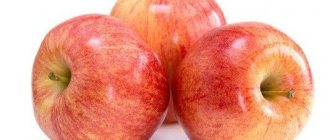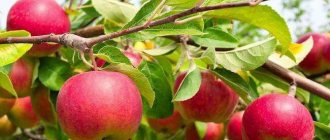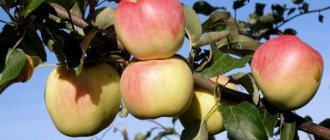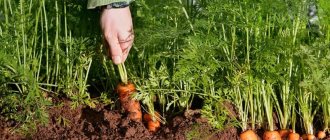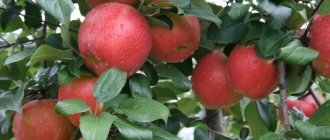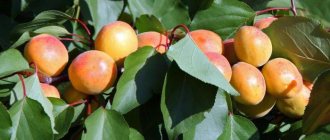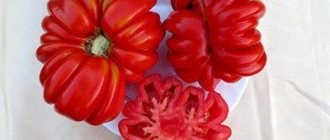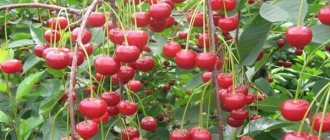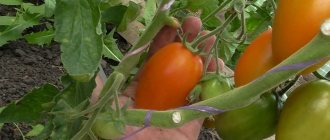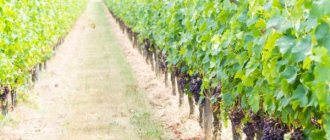The apple tree variety, a gift for gardeners, is one of the most popular, as it is characterized by stable yields in regions with risky farming. Fruits of this species are characterized by high taste and can be stored for a long time if certain conditions are met. The name of the variety fully meets the expectations of gardeners, since to get a good harvest of apples you just need to follow the general rules of care.
“Gift for Gardeners” - a universal variety
Features of the variety
Initially, this variety was bred specifically for cultivation in regions with harsh climatic conditions - in the West and Siberia. Later, the crop began to be successfully cultivated in other regions of the country - in the south, in the Moscow region and in the Middle Zone.
Advantages:
- high disease resistance to scab and other diseases;
- good frost resistance - with good shelter in low temperatures (-30°), the percentage of freezing of fruit shoots and flower buds is minimal;
- the harvest has an excellent taste and is intended for universal use - it is consumed fresh and suitable for preparing for the winter;
- in conditions of low humidity and coolness, apples do not lose their taste and marketability until spring.
This variety has two drawbacks - poor drought tolerance and small fruit.
Advantages and disadvantages
This variety has advantages and disadvantages. Therefore, when choosing it, you should pay attention to them.
The “Gift for Gardeners” variety can be used as a basis for breeding new species
The main advantages of the variety:
- stable yield;
- presentation of apples;
- excellent taste;
- versatility of use;
- fruits can be stored and transported for a long time;
- quickly recovers when frozen;
- immune to scab and weather conditions;
- does not require pollinators.
Flaws:
- small apples;
- the tree cannot tolerate even short-term drought;
- average resistance to frost.
Tree and fruit
Apple tree Gift for gardeners of short stature - reaches 3 in adulthood. The crown is compact, round, of medium density. Fruit ovaries are formed on almost all shoots - old and young growth.
The trunk and branches are covered with smooth brown bark; the surface contains slight pubescence. The leaves are green in color, dense, round or oval in shape with a pointed end.
The fruits are small in size - weigh 70-100 g, round, sometimes flattened in shape. The skin is thin, smooth with a slight waxy coating. When fully ripe, apples are yellowish-green in color with a slight reddish blush. They are formed on thin and not too long stalks.
The pulp is light green in color, juicy, fine-grained, sweet in taste and has a pronounced apple aroma. It contains 5.30% pectins, 1.22% titratable acids, 300 mg of P-active acids, 60 mg of tannins and 25 g of ascorbic acid.
Apple tree Gift for gardeners
A real gift to gardeners was presented by a group of scientist-breeders from the Siberian Research Institute of Horticulture named after M.A. Lisavenko in 1959, having received a hybrid from Melba and Laletino.
The result of their work became the embodiment of all the dreams of gardeners, having adopted all the best from their parents:
- Excellent adaptation qualities;
- Resistance to the most common diseases;
- Winter hardiness;
- Taste qualities of fruits.
The variety is zoned in Western Siberia and in almost all regions of our country.
Important! It should be grown with caution in the southern regions, as it does not tolerate drought well.
Advantages and disadvantages
The main advantages of the variety:
- Winter hardiness;
- High commercial quality of fruits;
- Excellent transportability and keeping quality.
Gift apples for gardeners have high commercial quality.
Disadvantages of the variety:
- Does not tolerate soil drying out;
- The fruits are classified as small and medium in size.
Tree morphology
reaches three meters in height , the crown is rounded, strong, medium-thick , formed from medium-sized brown straight shoots. The leaves are gray-green, medium in size, elliptical in shape, slightly pointed at the end, with crenate serrations along the edge.
Apple tree Gift for gardeners.
Productivity and characteristics of fruits
The apple tree variety, a gift for gardeners, can be classified as medium-fruited, the fruits can reach an average weight of 90 g, one-dimensional, round, slightly flattened in the center.
The skin is smooth and shiny, yellow-green, dense, with light ruddy red streaks on most of the apple.
The pulp is fine-grained, dense, crispy, white with a delicate light green tint, juicy and has an amazing sweet and sour taste and delicate aroma.
The pulp contains:
- Ascorbic acid 25 mg/100g,
- Sakharov - 13.3%.
The yield is average 30 kg of apples can be harvested from one mature tree annually.
Winter hardiness and disease resistance
The apple tree of this variety is winter-hardy , able to withstand sudden temperature changes and quickly recover from harsh winters. This is a variety of Siberian selection , only later zoned in warmer regions, so frost resistance is its main advantage.
Winter hardiness is one of the advantages of the variety.
Resistance to diseases is average , resistance to scab . However, the tree may be subject to attacks by insect pests and rodents, but precautions and timely prevention will help you avoid such problems.
Secrets of successful cultivation
Seedlings are planted in both spring and autumn
To grow a strong and healthy tree, you need to choose high-quality planting material.
It is advisable to buy it in gardening nurseries if you want to get a real variety. Seedlings are purchased a couple of weeks before the planned planting.
You can plant an apple tree in both spring and autumn.
Selection of seedlings
When choosing planting material, the following criteria must be taken into account:
- Choose plants that are 1-2 years old. They take root faster and adapt to new growth conditions.
- The roots must be strong, healthy, without signs of damage by diseases, parasites and without mechanical trauma. One tree should have several developed roots with a length of at least 40 cm. Ideally, the roots should have the remains of an earthen clod.
- When purchasing, inspect the above-ground part - it should not be dry, limp or without leaves.
- There should be no mechanical damage, cracks or breaks on the bark of the trunk and shoots.
- To plant on your site, select those specimens whose vegetative buds have not yet awakened.
Questions from our readers
How to distinguish seedlings of the Gift for Gardeners variety?
Gardener's Gift seedlings have strong, medium-thick, straight branches with bluish-green leaves.
When choosing, you should pay special attention to the root system if the seedling is sold with an open root system: make sure that the roots do not have rotten or dried areas.
What to do if the apple tree does not bear fruit?
A self-fertile apple tree cannot bear fruit for several reasons:
- Incorrect feeding scheme. An excess of nitrogen can lead to rapid development of green mass and suppression of ovaries. Review the fertilizers you use and stop using ammonium nitrate;
- Incorrect cropping . When pruning in spring, do not try to make the haircut more interesting, make sure that you do not remove the shoots on which fruits should form;
- Strong deepening of the root collar. It is more difficult for deeply planted trees to develop, so simply free the root collar from excess soil.
Landing rules
The purchased planting material must be placed in warm, settled water for 2-3 hours.
Deadlines
If you plan to plant seedlings in the spring, then it is better to carry out this procedure at the end of April or early May, when the threat of the last frost has passed. Autumn planting takes place in early or mid-October. The timing of planting is determined depending on the climatic conditions and weather in the region.
In places where autumn is dry and cool, spring planting of seedlings is recommended; in other regions, autumn planting will be preferable. Plants planted in the fall have a lot of time to adapt to their new location and prepare for the upcoming growing season in the spring.
Site preparation
Its further growth, health and quality of fruiting will depend on how correctly you choose the site for growing this variety.
This crop loves the sun, so it needs to be planted in a sunny place where there are no drafts. Select an area that has had time to recover and take a break from other vegetation over the course of 2-3 years.
If this is not the case, you need to select any sunny area and completely replace the old soil in the planting hole with new soil, adding organic and mineral fertilizers.
The apple tree likes to grow on loamy soil with a neutral acidity level and a high content of organic components.
In areas with close groundwater flow, good drainage is ensured from a thick layer of sand. Such an embankment will prevent rotting of the root system, which grows up to 1.5 m deep.
Landing technique
Do not plant seedlings close to each other
Planting holes are prepared 3-4 weeks before the planned planting of seedlings. The holes are dug at a distance of 3.5-4 m from each other. Its size should correspond to the size of the root system: optimal depth is 70-80 cm, width is 1 m.
When digging, the top layer of soil is folded back and mixed with peat and humus (compost, manure). Additionally, superphosphate (200 g) and wood ash (250 ml) are added to this mixture.
When planting on loamy soil, the soil mixture is mixed with sand; on sandy soil, clay is added to ensure moisture retention.
A third of the depth of the planting hole is filled with a nutrient composition, the roots of the plant are lowered, straightened, a wooden or metal stake is driven side by side for support and covered with garden soil. When planting, it is important that the root collar on the trunk is slightly above the soil surface. The soil around the tree trunk is compacted, watered generously and covered with peat, humus or ordinary soil. The plant is tied to a peg with twine.
Description and characteristics of the apple tree Anise
The apple variety Anis is an autumn apple variety. Some time ago they were popular along with Antonovka and other modern varieties. The tree has a spreading pyramidal crown, often dense in the middle. The apple tree grows tall, spreading, and takes up a lot of space in the garden. This must be taken into account when planting Anise on the site.
The apples grow large, with yellow skin and reddish stripes. The weight reaches 300 g, but with age they begin to become smaller. The pulp is creamy, juicy, slightly grainy, sweet, brightly aromatic and slightly sour. The fruits contain a lot of ascorbic acid. Despite their sweet taste, apples are low in calories and are therefore recommended during a diet.
What is the height of the apple tree
The tree grows tall with a spreading, wide crown. The apple tree grows more than 5-6 m. Plus it gives a lot of shade, so it is better to plant it in that corner of the garden from which it will not shade the entire area. It is also necessary to calculate the territory of the tree trunk circle.
How long does an apple tree live?
With proper care, Anise can live for almost 20 years or even more. Moreover, at 30 years old you can collect more than 300 kg from a tree, but every year the crown thickens more and the fruits become smaller. Therefore, constant rejuvenation of the tree is necessary.
There is information about record Anise apple trees, which are already about 100 years old. This is quite possible.
How long does it take for an apple tree to bear fruit?
The variety begins to bear fruit 4-5 years after planting. The harvest is harvested from three-year-old branches. The tree bears fruit for a very long time. Up to 200-250 kg of crop is harvested from one apple tree.
How long does an apple tree bloom?
Flowering begins in late spring - in May, but also depends on the weather. The apple tree blooms very beautifully. The flowers have a pale pink tint and a greenish tint. After flowering ends, fruits weighing no more than 100 g are formed. Typically, apples reach a size of 60-80 g.
The best pollinators for the Anise variety
Anise itself is an excellent pollinator. This variety is a good neighbor. For a rich harvest, pollinators such as Yandykovskaya, Bellefleur-Chinese, July Chernenko, and Borovinka are suitable for him. Also, don’t forget about Antonovka and Korichnevoe (Cinnamon) striped.
Ripening time
Anise can be harvested in the fall - in September. The remaining apples may still ripen in early October. The exact timing depends on the variety of Anise. The general ripening period is from the end of August to the first days of October. Apples keep well. After ripening they do not fall off the tree.
Productivity
This is a high-yielding variety. From one mature tree you can collect up to 300 kg of apples. Even by the standards of other trees, from old apple trees (20-30 years old) you can get a bountiful harvest of up to 300-320 kg. Although on average it turns out to be about 80-100 kg. But Anise has a property - the higher the yield, the more prone the tree is to periodicity. That is, if in the previous year there were a lot of apples, then the next year it can rest from fruiting.
Frost resistance
The variety also has excellent resistance to low temperatures. The apple variety Anis survives frosts well down to -40 degrees. Even if a tree is damaged during winter, it is quickly and easily restored.
Resistance to major diseases
But Anise cannot boast of resistance and immunity to diseases. They often suffer from black cancer, powdery mildew, scab and other ailments. May be attacked by pests. Therefore, it is necessary to carry out careful prevention and, if signs are detected, begin treatment immediately.
Harvest storage
Apples store well, especially if picked unripe. They can stay until March. It all depends on the variety and time of ripening. The later the apples ripen, the longer they last.
Pay attention to:
Care requirements
Watering
At the initial stage of growth, seedlings need good and regular watering. Warm, settled water is added to the tree trunk zone when the surface layer of soil dries out.
Young trees are moistened throughout the spring-autumn period; adult trees continue to be moistened almost until the first autumn frosts.
Watering is carried out as follows:
- at the beginning of the growing season for mature trees (young seedlings are watered 2 weeks after planting);
- 2 weeks before the expected flowering;
- during shedding of excess fruit ovaries;
- at the stage of pouring apples;
- after autumn leaf fall.
In dry summers, the frequency of watering is increased, because... This crop does not tolerate drought well.
Depending on the age of the tree, different amounts of water are used: for young trees (age 1-3 years) 5 buckets are enough, for fruit-bearing trees - 8-10 buckets.
Mulching and loosening
A day after moistening, the soil is loosened, then the tree trunk area is mulched with peat, humus or garden soil. Mulch will protect the soil from drying out and prevent the growth of weeds.
Sawdust, spruce branches, shavings and tree bark are not suitable for mulching, because these components increase the acidity of the soil, which is extremely undesirable for wood.
To increase the moisture and breathability of the soil, the apple orchard is sown with useful vegetation - meadow bluegrass, perennial ryegrass, meadow fescue and red fescue.
With the onset of autumn, the soil in the area around the tree trunk is dug up superficially onto the floor of the bayonet of a garden shovel.
Fertilizers
The yield of this crop directly depends on the quality of nutrition. In the first two years, young trees are not fed, because they only need the nutrients that were added during planting.
In the third year, in early spring, the seedlings are fertilized with mullein infusion, and in late spring or early summer, foliar nutrition is carried out with mineral compounds (Tsitovit, Kristalon, Master, Sudarushka or Mortar).
A few days before flowering, the tree trunk area is sprinkled with organic matter - compost or humus, watered abundantly and mulched.
Fruit-bearing trees are additionally fed in the fall with phosphorus-potassium preparations (potassium sulfate - 30 g and the same amount of superphosphate) and wood ash - 250 ml. After adding these components, the area is dug up.
Young seedlings that have not yet begun to bear fruit are given foliar nutrition - the crown is irrigated with a urea solution (35 g of the substance is dissolved in 10 liters of water). Spraying of the aboveground part is carried out twice - after flowering and again a month later.
Pollinators and care
The variety is self-sterile; Moskovskoe later, Studencheskoe and Sinap northern will serve as good pollinators for it. Fruiting occurs most often on biennial or perennial wood.
The form is not fast-bearing; the authors of the variety promise the first harvest in 5-6 years. However, now dwarf rootstocks, for example MM 106, have become popular, and on them the trees turn out to be more compact and begin to bear fruit earlier. In any case, if buds appear on a freshly planted tree, it is recommended to remove them.
The frost resistance of the variety is excellent, down to -42°C, which is even better than that of Antonovka, recognized as the standard for the central zone. In addition to its outstanding resistance to frost, Podarok Grafsky is pleased with its rapid recovery. Resistance to scab and pests is also above average, but in some years it is necessary to carry out several protective treatments with chemicals. The variety is not drought-resistant, so throughout the growing season it is necessary to provide the plant with plenty of moisture.
In addition to watering, spraying and spring pruning, trees gratefully respond to fertilizing. The most common organic fertilizer is traditionally considered to be manure. It is better to introduce it already rotted, in the fall for digging, in the spring, or make water extracts and water with this solution.
Potassium compounds are of great importance for flowering and setting. This useful element is contained in wood ash, which can be applied to plants in any season. Closer to autumn, nitrogen fertilizers are replaced with phosphorus-containing ones.
Prevention of diseases and pests
Crohn's disease requires treatment
The Gift variety is resistant to disease; powdery mildew may appear on apple trees only in rainy summers. To prevent this disease, copper-containing preparations are used - Bordeaux mixture or copper sulfate.
Treatment of the crown and trunk area is carried out in early spring and late autumn in cloudy and windless weather. These same drugs are also used for medicinal purposes against diseases.
Sometimes a tree can get bacterial canker. The disease is incurable, so it must be immediately removed and burned to prevent infection of healthy plantings.
During the fruiting period, the tinder fungus is dangerous - it causes great harm to the harvest and the health of the tree. The affected areas must be cut out, treated with copper sulfate and covered with garden varnish.
To prevent and maintain the health of the apple tree, you should:
- regularly feed with complex compounds that increase immunity;
- periodically free the crown from dried, frozen and broken branches, and also thin it out to ensure good air ventilation;
- with the onset of autumn, thoroughly clean the area from fallen leaves, plant debris and weeds;
- Before the onset of cold weather, treat the lower part of the trunk with a solution of slaked lime.
Trimming
Formation of the crown and regular pruning of branches is a mandatory procedure for caring for an apple tree. Both manipulations are necessary for active growth, increasing yields, protection from winter cold and increasing life expectancy.
Pruning is carried out in early spring before the sap begins to flow and in late autumn after leaf fall.
The first pruning of seedlings is carried out a year after planting - the central stem is shortened by 20 cm and the side shoots are shortened by 15 cm. This manipulation stimulates dense branching. The cut areas are treated with copper sulfate, then covered with garden pitch.
Additionally, remove all branches damaged during the winter, as well as shoots that have shriveled and been damaged by disease. Growing shoots inside the crown are cut into a ring.
In the fall, the shoots of the current year are pruned in young trees by 5-7 cm; in mature trees, all branches are trimmed to a third of the length.
Formation
A sparsely tiered crown shape is suitable for this variety. Formation takes place in several stages:
- in the 1st year, the strongest and thickest shoots are left on the trunk in the amount of 3-4 pieces at a distance of 30-40 cm from each other;
- the next year, 3 branches are left in the second row;
- in the 3rd year 2 branches.
Fruiting
The tree begins to bear fruit 2 or 3 years after planting, and the amount of harvest increases with the age of the plant. After 6 years, the apple tree can bear the maximum amount of fruit. Apples are usually harvested in September. They can be eaten fresh or used for preparations. Apples of this variety make very tasty juices, jams and compotes. Apples can be dried and also added to various dishes.
If the apple tree does not bear fruit, there may be several reasons for this:
- Incorrect feeding. If too much nitrogen-containing preparations have been added, then all the tree’s energy will be spent on growing green mass. In this case, there will be very few ovaries. To eliminate this reason, the application of ammonium nitrate should be discontinued.
- The formation of the tree crown also affects fruiting, since only those shoots that do not bear fruit should be removed.
- If the root collar was very deep during planting, then it is also very difficult for the tree to grow and develop. The solution to the problem is to dig out the root collar from underground.
The shelf life of the fruit is approximately 200 days.
Ripening and harvesting
Fruit ovaries are formed on the shoots of the current and last year. The first apples begin to bear fruit in the 3rd-4th year of cultivation.
They ripen in early or mid-September. The harvest is carried out in one go, because the fruits ripen together and do not fall off.
The harvest can be stored in any cool room with a temperature of 1-3° and a humidity of 60%. To preserve marketability and taste, it is placed in wooden boxes or cardboard boxes, each layer layered with cardboard. In such conditions, the fruits will remain until spring.
A small amount can be stored in the refrigerator.
Advantages and disadvantages
The Gift to Grafsky variety is one of the best of its kind. According to experienced gardeners, the tree has virtually no disadvantages, and if they do exist, they are insignificant.
Advantages of the variety:
- winter hardiness;
- annual fruiting;
- the tree grows quickly;
- the fruits are bright, fragrant, moderately juicy;
- good preservation;
- perfectly transported over long distances;
- fruiting for 2-3 years;
- high resistance to scab and fungal diseases.
Although the shortcomings of the tree are minor, they still exist:
- the harvest is annual, but the number of fruits varies;
- the need for crown formation;
- poor lighting of the lower branches due to the shape of the tree crown;
- fruits of different sizes;
- During ripening, slight shedding of fruits is possible.
Gift to Grafsky is an excellent variety that is grown in different regions of the country. Abundant fruiting, a beautiful crown, delicate pale pink flowers, fragrant fruits - qualities that are highly valued by many orchard lovers.
Growing in different regions
As practice shows, growing this crop in the Moscow region has a positive result. In summer, it is important to ensure moderate and regular soil moisture.
According to the description, the variety was bred specifically for planting in a harsh climate zone, so it is perfect for Siberia and the Urals.
There are no special recommendations when growing in Altai, since this variety is zoned and adapted to this zone.
About apple tree varieties for Siberia
10.Choose an apple tree. The best varieties of apple trees: Melba, Mantet and others.
Apple trees for Siberia
